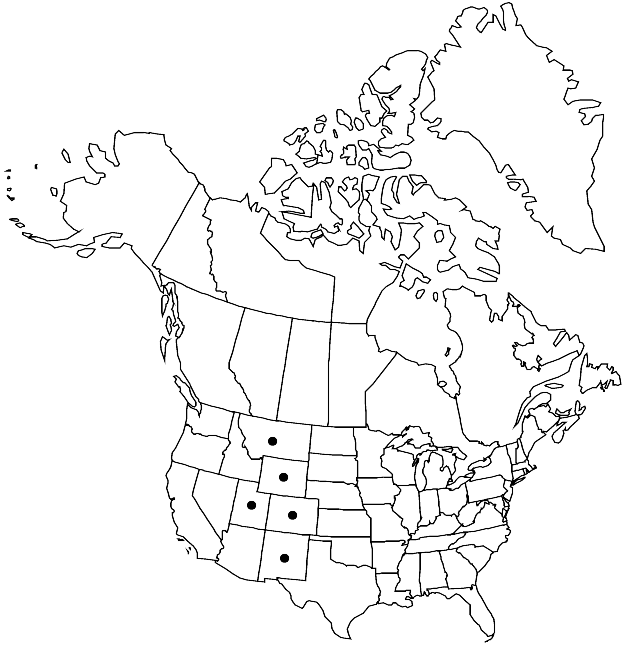Difference between revisions of "Draba crassa"
Mem. New York Bot. Gard. 1: 182. 1900.
FNA>Volume Importer |
FNA>Volume Importer |
||
| Line 26: | Line 26: | ||
|elevation=2900-4300 m | |elevation=2900-4300 m | ||
|distribution=Colo.;Mont.;N.Mex.;Utah;Wyo. | |distribution=Colo.;Mont.;N.Mex.;Utah;Wyo. | ||
| − | |discussion=<p>Draba crassa is easily recognized by its combination of fleshy, distinctly petiolate leaves with glabrous surfaces and mostly decumbent flowering/fruiting stems. N. H. Holmgren (2005b) indicated that it has 52 seeds per fruit (26 per locule), but in the plants we examined, the seed count did not exceed 20 per fruit.</p> | + | |discussion=<p><i>Draba crassa</i> is easily recognized by its combination of fleshy, distinctly petiolate leaves with glabrous surfaces and mostly decumbent flowering/fruiting stems. N. H. Holmgren (2005b) indicated that it has 52 seeds per fruit (26 per locule), but in the plants we examined, the seed count did not exceed 20 per fruit.</p> |
|tables= | |tables= | ||
|references= | |references= | ||
| Line 50: | Line 50: | ||
|publication year=1900 | |publication year=1900 | ||
|special status= | |special status= | ||
| − | |source xml=https://jpend@bitbucket.org/aafc-mbb/fna-data-curation.git/src/ | + | |source xml=https://jpend@bitbucket.org/aafc-mbb/fna-data-curation.git/src/8f726806613d60c220dc4493de13607dd3150896/coarse_grained_fna_xml/V7/V7_391.xml |
|tribe=Brassicaceae tribe Arabideae | |tribe=Brassicaceae tribe Arabideae | ||
|genus=Draba | |genus=Draba | ||
Revision as of 17:57, 18 September 2019
Perennials; (cespitose); caudex simple or branched (well-developed, with persistent leaf bases); not scapose. Stems (decumbent to ascending), unbranched, (0.4–)0.6–1.3(–1.5) dm, usually glabrous proximally, rarely sparsely pubescent, pubescent distally, trichomes simple and short-stalked, 2-rayed, (crisped), 0.1–0.6(–0.8) mm. Basal leaves rosulate; petiolate; petiole ciliate, (trichomes mostly simple, 0.3–0.8 mm); blade oblanceolate, 2–6(–7) cm × 2.5–8(–10) mm, margins entire, (pubescent as petiole), surfaces glabrous. Cauline leaves 2–4(–6); sessile; blade ovate to oblong, margins entire, (ciliate, trichomes simple and stalked, 2-rayed). Racemes (4–)8–20(–25)-flowered, ebracteate, elongated in fruit; rachis not flexuous, pubescent, trichomes simple and short-stalked, 2-rayed, (crisped), (0.1–0.8 mm). Fruiting pedicels divaricate-ascending, straight, 5–10(–15) mm, pubescent as rachis. Flowers: sepals (green tinged purplish), ovate to oblong, 2–3(–3.3) mm, pubescent, (trichomes simple and 2-rayed); petals yellow, spatulate to subobovate, 3.5–5(–6) × (2–) 2.5–3.5(–4) mm; anthers ovate, 0.5–0.6 mm. Fruits lanceolate to ovate-lanceolate, slightly twisted, flattened, (7–)8–14 × 3–5 mm; valves glabrous; ovules 16–20 per ovary; style (0.4–)0.7–1.2(–1.5) mm. Seeds oblong, 1.2–1.7 × 0.8–1.1 mm. 2n = 24.
Phenology: Flowering Jul–Aug.
Habitat: Rock outcrops and talus, alpine tundra, rocky meadows
Elevation: 2900-4300 m
Distribution

Colo., Mont., N.Mex., Utah, Wyo.
Discussion
Draba crassa is easily recognized by its combination of fleshy, distinctly petiolate leaves with glabrous surfaces and mostly decumbent flowering/fruiting stems. N. H. Holmgren (2005b) indicated that it has 52 seeds per fruit (26 per locule), but in the plants we examined, the seed count did not exceed 20 per fruit.
Selected References
None.